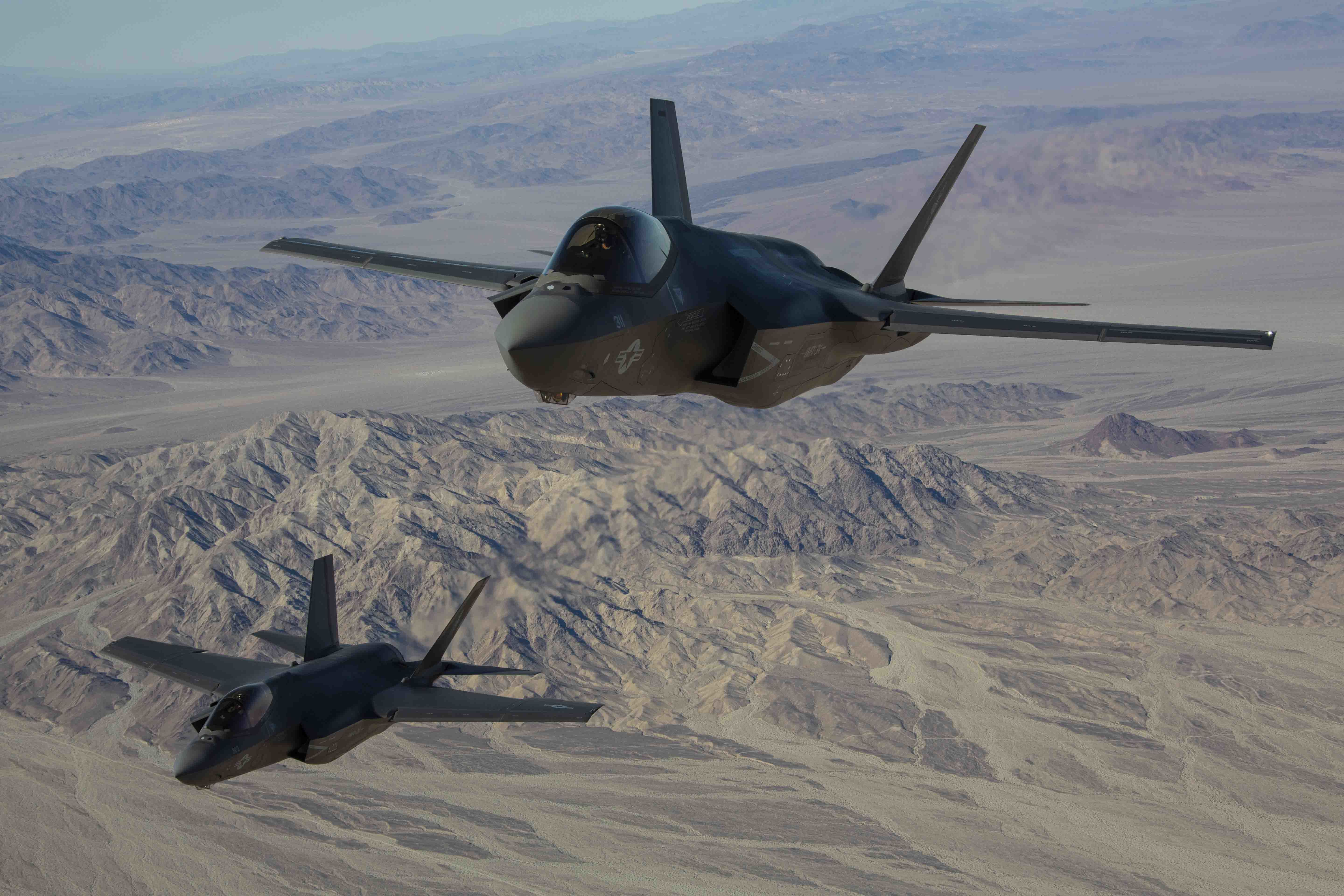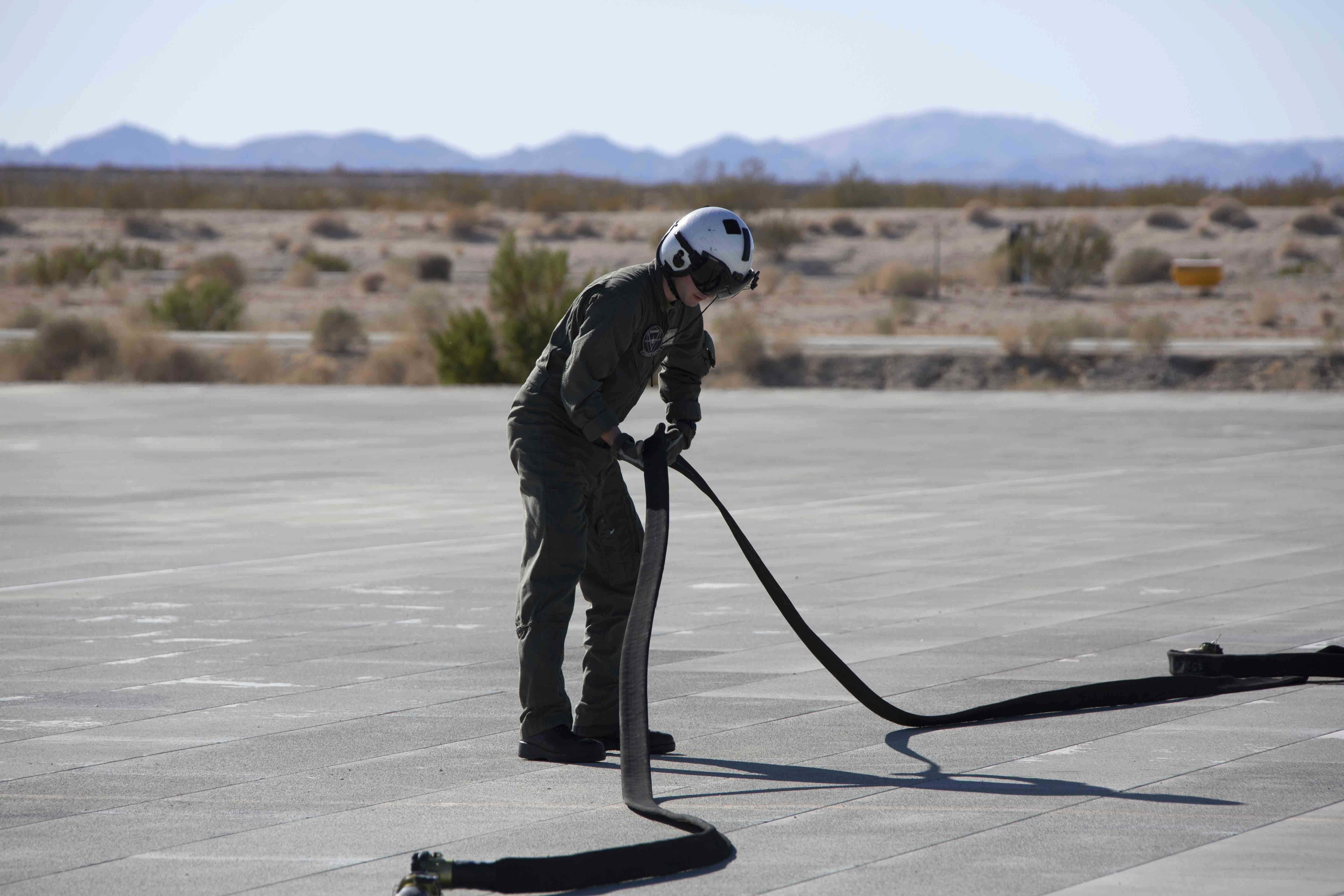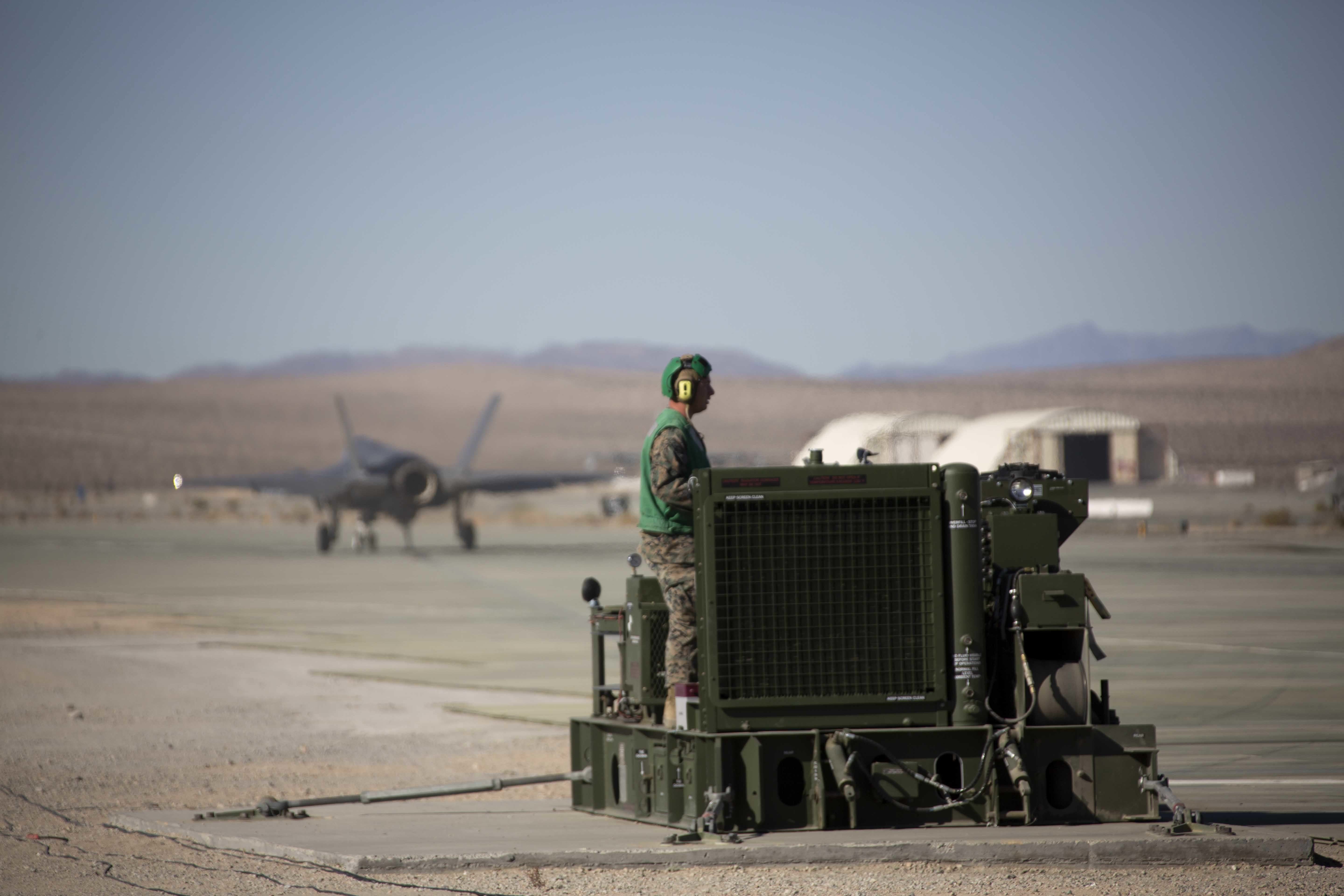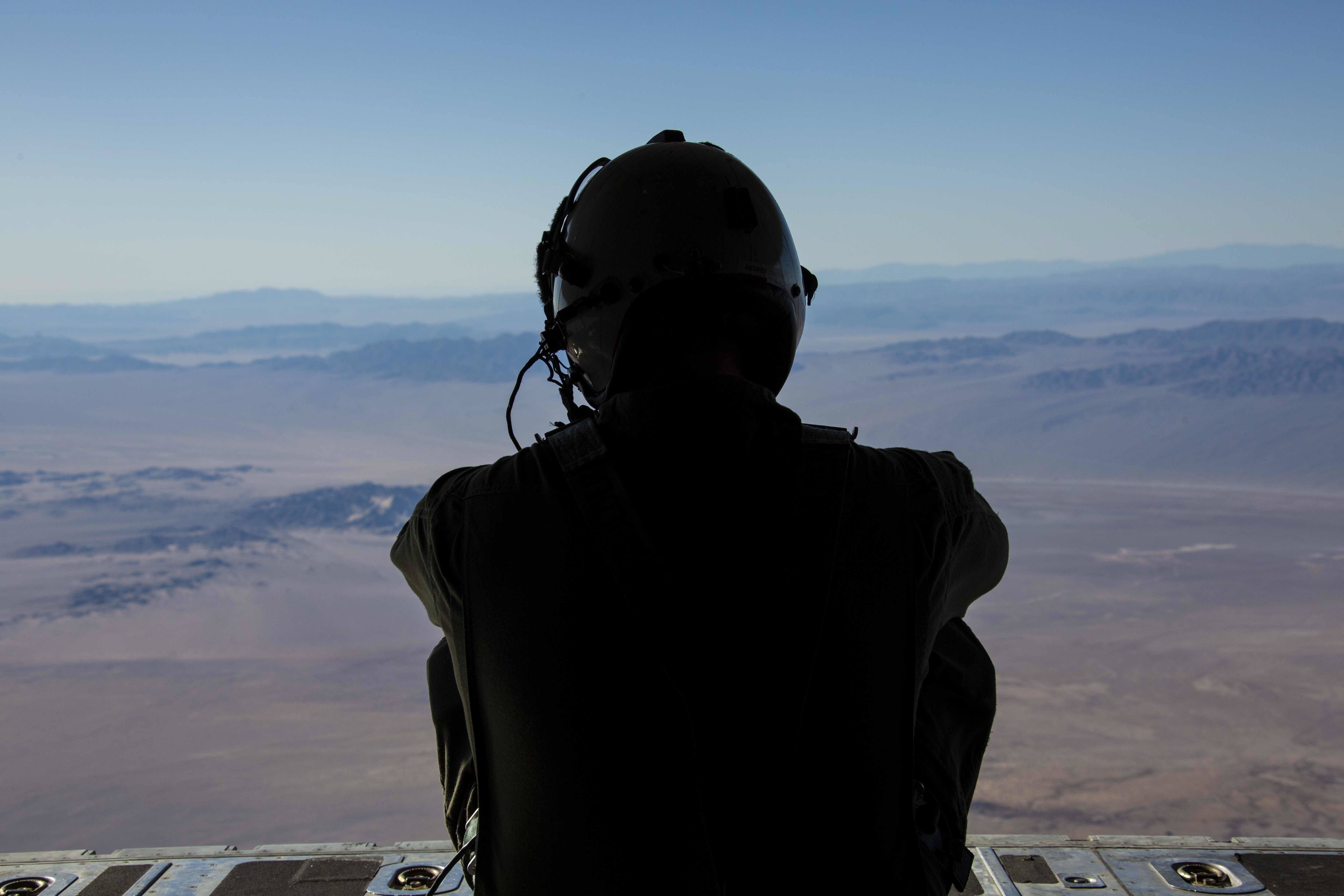
SAN DIEGO, Calif., – The Marine Corps’ first carrier-capable F-35C Lightning II squadron demonstrated, for the first time, the capability to quickly rearm and refuel at expeditionary land bases, a mission key for future island-hopping operations that top leaders envision the U.S. military will face.
Maj. Robert Ahern of Marine Fighter Attack Squadron 314 was the first to land the F-35C at the expeditionary landing field at Marine Corps Air Ground Combat Center in Twentynine Palms, Calif., last week.
The jet’s landing gear hit the AM2 metal matting and its tailhook grabbed the arresting cable at the desert training base. VMFA-314 crews quickly descended on the jet to refuel its tanks from a KC-130 Hercules tanker airplane and arm the jet with a pair of 1,000-pound GPS- guided bombs. About 10 to 15 minutes later, the jets launched back into the air to complete a scheduled bombing mission.
The Dec. 3 flight demonstrated the expeditionary landing capability for the carrier version of the F-35 on land using the M31 Expeditionary Arresting Gear System installed at the desert EAF. It was the culmination of a training effort that began in June that would prepare the squadron for future expeditionary advanced base operations or EABO.

But there was a hurdle. “The ‘hot reload-hot refuel’ combination was not certified for the F-35C,” said Ahern, a former F/A-18C Hornet pilot.
The “Black Knights” of VMFA-314 are slated to deploy in late 2021 aboard aircraft carrier USS Abraham Lincoln (CVN-72). But while contractors and the joint program officer continue M31 arresting gear testing and data analyses, Ahern said, certification wasn’t slated to happen until fiscal 2024.
That timeline “doesn’t really work for us, because we are deploying with Carrier Air Wing 9,” he said. “We may be called upon to execute expeditionary advanced base operations. We need to be able to do this. This is something that hasn’t been done yet with the F-35C.”
“It’s a very efficient evolution,” he added. “Now if I land the jet and I stay in it, you reload the jet I can do that in 10 to 20 minutes and the jet is ready to go, so we will definitely use that capability.”
While at the recent Weapons Tactics Instructor course at Yuma Marine Corps Air Station, Ariz., the VMFA-314 set out to demonstrate the capability to do a hot refuel/rearm trapping at an EAF.
“We got that certification. The ordnance team went through a bunch of demonstrations, first with the jet off and finally with the jet running, loading weapons in the bays and on all the stations on the wings and while getting refueled at the same time,” Ahern said. The next hurdle “was to get the M31 arresting gear certified for the F-35C. Never been done before, and it’s something that has been used by F/A-18s for years.”
The M31 system is “designed to be set up anywhere, where you basically bolt this thing to the ground on either side of the runway and then you string cable between it,” he said, noting “you can conceivably build a small airfield or you have a strip of highway that makes sense or maybe you have a runway that part of it is cratered and you can only use half of it.”
How they did it

The demonstration happened after much discussion and work among squadron members, engineers and others, Ahern said. They had to analyze and calculate ground speed at landing and max weight at trap, so they used carrier landing data as a starting point. Then they requested 3rd Marine Aircraft Wing to provide a KC-130 Hercules from the “Raiders” of Marine Aerial Refueler Transport Squadron 352 for a full day’s support at MCAGCC, where Marine Wing Support Squadron 374 runs the airfield and operates the M31 system.
Fourteen Marines in two of the squadron’s ordnance teams and ground crews boarded the Hercules for the morning flight to Twentynine Palms. There, they set up the air-delivery ground refueling system that enables fuel to flow from the KC-130 either with its rotors turning or off via a hose to the receiving aircraft.
After trapping at the EAF, Ahern taxied over to the KC-130 parked nearby at the refuel/rearm area and squadron crews simultaneously refueled the F-35C and loaded GBU-32s, a GPS-guided, 1,000-pound bomb, one in each weapon bay.
“We park the jet once, and it all happens at the same time. Like a NASCAR pit crew,” Ahern said.
It took a few minutes after Ahern landed for the MWSS Marines to reset the arresting gear for his wingman to land. “My jet was fueled and ready in 10 minutes,” he said. Once his wingman got refueled, armed and cleared to fly, both pilots left for a bombing range near Yuma to attack targets before returning to Miramar.
Squadron Marines including the ordnance “worked all the details to get everyone on the Herc and loaded, Ahern added. “There was a ton of coordination that had to happen. They get to an airfield that most of them had never set foot on, and then immediately had to execute, and they crushed it.”
Extended reach

The F-35C’s large internal fuel tanks give it more fuel – and reach – than any of the JSF variants, enabling it to carry up to 20,000 pounds of fuel.
“Your ability to stay on station and provide support is exponentially better than any other platform that is out there, with maybe the exception of a (F-15E) Strike Eagle the Air Force has,” Ahern said. “We are far and away the best for time-on-station range, and that matters.”
During a previous tour flying the F/A-18C over Syria and Iraq for Operation Inherent Resolve, “we had to go to the tanker all the time, because you had to maintain above a certain ‘bingo’ number and there were certain airfields you could divert to, so you need a lot of gas,” he said. But with the F-35C, “you hit the tanker a lot less and have a lot more options available and provide continuous support that other platforms could not.”
The F-35C’s capability to hot refuel/hot rearm at forward bases, such as on atolls or at remote airstrips – is a complementary capability to carrier operations and extends its reach when operating off deployed carriers. “For expeditionary base operations, we just need a small landing strip, whether we’ve built one ourselves or we’ve captured one,” he said. “It could be on a peninsula, it could be deep in a territory… and now I can refuel and I’m right back in the fight, vice having to fly back potentially hundreds of miles to some other more built-up location.”
“If we are called upon to push forward from where the carrier could be, in a higher fight, then now with this demonstrated capability, we could land at a small island airstrip, with expeditionary gear, similar to World War II island-hopping,” he said. “I can get bombs and gas and get right back into the flight without having to fly back to the carrier.
“We’ve tested and proven in the F-35C.”
The F-35C carries almost twice the fuel and “bigger and better weapons than the F-35B could carry,” he said, referring to the short takeoff and landing variant the Marine Corps has planned to buy in greater numbers than the carrier variant of the fifth-generation fighter.
The F-35C can complement the F-35B in supporting missions including armed reconnaissance, enemy suppression, strike coordination and close-air support, the latter the “bread-and-butter” mission for Marines.
“We have the flexibility for the what-if,” he said. “No plan survives first contact with the enemy, right? SO if you have this perfect plan for how the fuel is going to work out, and something changes it, you don’t have a margin of now I have to leave… leave for a period of time just to get gas… CAS is to provide support, and being overhead is doing that.”
The “Black Knights” got their first F-35Cs earlier this year and recently reached IOC, or initial operational capability. The squadron has 10 jets and is fully staffed with 14 pilots, who have been average 20 to 25 hours of flight time a month, Ahern said. Additional pilots are expected to join the 14 currently assigned before predeployment workups begin this spring at Lemoore NAS, Calif., with CVW-9.
“We’ve crawled, we’ve walked, and we need to start running so as we get on the ship, we can execute, at a high level, fully integrated” with the wing’s squadrons.





